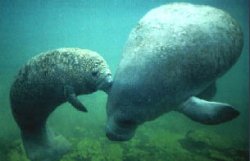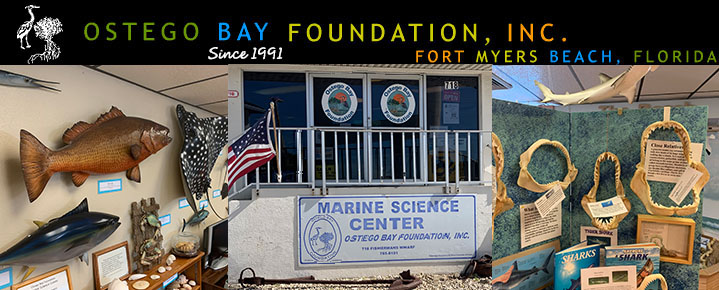|
|
Mission Manatee |
|
Mission Manatee
is a program to investigate the Estero Bay manatee population and to
record and document behavior, scarring, and migration patterns.
Through education, we plan to create an awareness and understanding
of our endangered manatee. |
| Name |
| Florida Manatee
(Trichechus manatus) |
| Description |
|
Large,
seal-like body that tapers to a beaver-like tail. Two forelimbs with
three or four nails on each. Thick skin, with stiff whiskers on
upper lip. |
| Color |
| Gray or
gray-brown |
| Size |
|
9 to 10 feet
long, weighing 1000 lbs. Can grow to be 13 feet, weighing more than
3000 lbs. |
| Behavior |
| Completely harmless and
non-aggressive |
| Vision |
|
Depth
perception may be limited. Can differentiate colors |
| Hearing |
|
Despite absence
of external ear lobes, can hear well but directional hearing is
limited |
| Communication |
|
Emits sounds
that are within human auditory range. May squeak or squeal when
frightened. Also communicate between cow and calf. |
| Breathing |
|
Nostrils on
upper surface of snout close tightly like valves when submerged.
When active, surfaces every few minutes. When resting, every 10-15
minutes |
| Range/Habitat |
|
Primarily
restricted to peninsular Florida and south Georgia. May be found in
shallow, slow-moving rivers, estuaries, salt water bays, canals, and
coastal areas particularlly where sea grass beds flourish. May live
in fresh or salt water |
| Reproduction |
| Normally calve
every 2 to 5 years | |
| Protection |
|
The manatee is protected under
federal law by the Marine Mammal Protection Act of
1972 and the Endangered Species Act of
1973, which make it illegal to harass, hunt, kill, or
capture any marine mammal. The manatee is also protected by the
Florida Manatee Sanctuary Act of 1978 which states:
"It is unlawful for any person, at any time, intentionally or
negligently, to annoy, molest, harass, or disturb any
manatee."
Anyone convicted of violating
this state law faces a possible maximum fine of $500 and/or
imprisonment for up to 60 days. Conviction on the federal level is
punishable by fine up to $50,000 and/or 1 year in prison. The state
of Florida can pursue prosecution under federal law in circumstances
of extreme harassment, resulting in death or injury of a
manatee. |
|
| Reporting |
| To report manatee
injuries, deaths, tag sightings, or harassment, call 1-800-DIAL-FMP
(1-800-342-5367)
The manatee is dependent on us for its
survival. It is only through your help and support that this "Gentle
Giant" may remain around for others to enjoy. |
 |
| Remember |
 |
Look, but do not touch a
manatee. Do not attempt to draw the animal closer to you by feeding
or watering it. |
 |
Do not pursue the manatee(s)
while swimming, boating, or observing. |
 |
Do not attempt to isolate an
individual manatee. Never separate a cow from her calf. |
 |
When boating, observe all
manatee speed zones and caution
areas. | |

